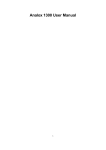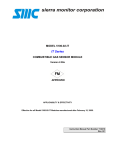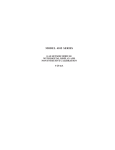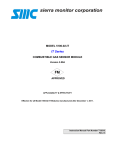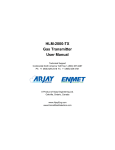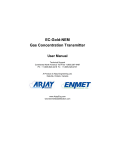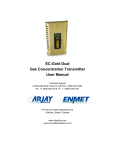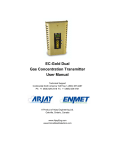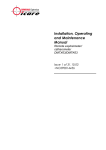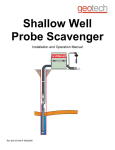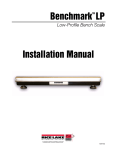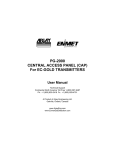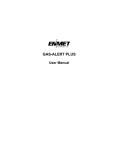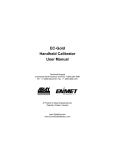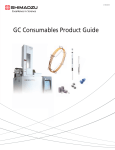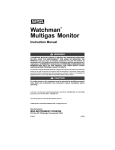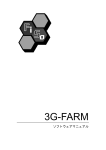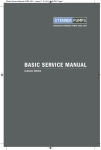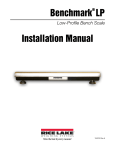Download HLM-2000-EX Flammable Gas Transmitter User Manual
Transcript
HLM-2000-EX Flammable Gas Transmitter User Manual Technical Support Continental North America Toll Free 1-(800) 387-9487 Ph: +1 (905) 829-2418 Fx: +1 (905) 829-4701 A Product of Arjay Engineering Ltd. Oakville, Ontario, Canada www.ArjayEng.com www.EnmetGasDetection.com HLM-2000-EX UM01.doc Model: HLM-2000-EX 1 Rev: 1.0 TABLE OF CONTENTS Section Title Page 1 TABLE OF CONTENTS..................................................................................................1 2 WARRANTY....................................................................................................................2 3 2.1 LIABILITY...........................................................................................................2 2.2 PRODUCT RETURN .........................................................................................2 2.3 MODIFICATIONS AND SUBSTITUTIONS........................................................2 PRODUCT INFORMATION ............................................................................................3 3.1 TRANSMITTER..................................................................................................3 3.2 FACTORY SETTINGS.......................................................................................3 3.3 CONTAMINANTS & INTERFERANTS ..............................................................3 3.4 4 3.3.1 CONTAMINANTS................................................................................3 3.3.2 INTERFERANTS .................................................................................4 OPTIONAL ACCESSORIES..............................................................................4 PRODUCT DESCRIPTION.............................................................................................5 4.1 GENERAL DESCRIPTION ................................................................................5 4.1.1 5 6 INSTALLATION...............................................................................................................6 5.1 LOCATION.........................................................................................................6 5.2 MOUNTING........................................................................................................6 5.3 CABLE SELECTION AND WIRING...................................................................7 5.3.1 FIGURE: Cable selection chart. ..........................................................7 5.3.2 FIGURE: Wiring layout. .......................................................................8 OPERATION AND CALIBRATION .................................................................................9 6.1 OPERATION ......................................................................................................9 6.2 CALIBRATION ...................................................................................................9 6.2.21 6.3.1 EQUIPMENT REQUIRED ...................................................................9 CALIBRATION PROCEDURE ...........................................................................10 6.3.1 7 SENSOR / TRANSMITTER SPECIFICATIONS .................................5 MEASURING SENSOR SWING .........................................................10 PREVENTIVE MAINTENANCE ......................................................................................12 7.1 GENERAL ..........................................................................................................12 7.2 TROUBLESHOOTING GUIDE ..........................................................................12 7.3 SENSOR REPLACEMENT................................................................................13 7.3.1 FIGURE: Sensor replacement and wiring procedure..........................13 1 Model: HLM-2000-EX 2 HLM-2000-EX UM01.doc Rev: 1.0 WARRANTY This Arjay Engineering Ltd. equipment is warranted against defects in material and workmanship from the date of shipment from factory. Please check equipment specifications following this page for particular warranty periods. Maintenance items are not warranted. During the warranty period, The Arjay Engineering Ltd. will repair or replace components that prove to be defective in the opinion of Arjay. Any equipment deemed to be defective by the user should be returned to The Arjay Engineering Ltd. for evaluation (see product return below). Site visits by Arjay Engineering Ltd. personnel, to evaluate / repair equipment, are not covered by this warranty. Arjay is not liable for auxiliary interfaced equipment, nor for consequential damage. This warranty shall not apply to any product, which has been modified in any way, which has been repaired by any other party other than a qualified technician or authorized Arjay representative, or when failure is due to misuse or conditions of use. 2.1 LIABILITY All ARJAY products must be installed and maintained according to instructions. Only qualified personnel should install and maintain the equipment. ARJAY shall have no liability arising from auxiliary interfaced equipment, for consequential damage, or the installation and operation of this equipment. ARJAY shall have no liability for labor or freight costs, or any other costs or charges in excess of the amount of the invoice for the products. THIS WARRANTY IS IN LIEU OF ALL OTHER WARRANTIES, EXPRESSED OR IMPLIED, AND SPECIFICALLY THE WARRANTIES OF MERCHANTABILITY AND FITNESS FOR A PARTICULAR PURPOSE. THERE ARE NO WARRANTIES THAT EXTEND BEYOND THE DESCRIPTION ON THE FACE THEREOF. WARNING CHECK TO ASSURE THE WORKING AREA IS FREE FROM HAZARDS DURING INSTALLATION OR WHEN PERFORMING MAINTENANCE, AND USE PROPER PRECAUTIONS. 2.2 PRODUCT RETURN All products returned for warranty or service should be shipped by prepaid freight and will be accepted only with an R.M.A. number issued by ARJAY. All products returned to the client will be shipped by freight collect. 2.3 MODIFICATIONS AND SUBSTITUTIONS Due to an ongoing development program, ARJAY reserves the right to substitute components and change specifications at any time without incurring any obligations. 2 Model: HLM-2000-EX HLM-2000-EX UM01.doc 3 PRODUCT INFORMATION 3.1 TRANSMITTER Rev: 1.0 Sensor/transmitter Unit Order Number …………………… Transmitter Part Number / WARRANTY…………………… Transmitter Serial Number.….……………………………… Sensor Part Number / WARRANTY….……………………. Sensor Serial Number…………………………………………. Power Supply Requirement………………………………… 12 to 26 VDC Current Consumption……..…………………………………. 300 mA max 3.2 FACTORY SETTINGS Gas Type……………………………………………….…..…. Range 4 – 20 mA Scale………………………………..……. Target Gas Ratio to Methane CH4..………………………….. 3.3 20% LEL CH4 = %LEL CONTAMINANTS & INTERFERANTS 3.3.1 CONTAMINANTS The performance of Arjay Engineering Ltd. catalytic combustion type gas sensors may be affected by exposure to substances known as poisons and inhibitors. Inhibitors are present in volatile substances containing halogens or sulphur compounds. Sensors may recover their sensitivity characteristics after exposure to inhibitors has ceased. Some substances produce a permanent poisoning effect on the catalyst. These poisons include silicone oils, greases and petroleum additives such as tetraethyl lead and phosphate esters. Always be cautious of by products that may evolve from the thermal decomposition of materials such as plastics. 3 Model: HLM-2000-EX 3.3.2 Rev: 1.0 INTERFERANTS Partial list of other gases that detector will respond to Acetaldehyde Acetic Acid Acetic Anhydride Acetone Acetylene Alkyl Alcohol Ammonia n-Amyl-Alcohol Aniline Benzene Biphenyl 1, 3-Butadiene n-Butane iso-Butane Butene-1 cis-Butene-2 trans-Butene-2 n-Butyl Alcohol iso-Butyl Alcohol tert-Butyl Alcohol n-Butyl Benzene iso-Butyl Benzene n-Butyric Acid Carbon Disulphide Carbon Monoxide Carbon Oxysulphide Cyanogen Cyclohexane Cyclopropane 3.4 HLM-2000-EX UM01.doc n-Decane Diethylamine Dimethylamine 2, 3-Dimethylpentane 2, 2-Dimethylpropane Dimethylsulphide 1, 4-Dioxane Ethane Ethyl Acetate Ethyl Alcohol Ethylamine Ethyl Benzene Ethylcyclopentane Ethylene Ethylene Oxide Dimethyl Ether Diethyl Ether Ethyl Formate Ethylmercaptan n-Heptane n-Hexane Hydrazine Hydrogen Cyanide Hydrogen Hydrogen Sulphide Methane Methyl Acetate Methyl Alcohol Methylamine Methylcyclohexane Methylethylether Methylethylketone Methyl Formate Methyl Mercaptan Methylpropionate Methyl n-propylketone Napthalene Nitromethane n-Nonane n-Octane n-Pentane iso-Pentane Propane n-Propyl Alcohol n-Propylamine Propylene Propylene Oxide iso-Propylether Propyne Toluene Triethylamine Trimethylamine Vinylethylether o-Xylene x-Xylene p-Xylene OPTIONAL ACCESSORIES The following options are available for your HLM-2000-EX Series Transmitter: HLM-2000-EX 6000-08 Duct Adapter HLM-2000-EX 6000-06 Splash Guard Note: The use of optional accessories may affect the response time. HLM-2000-EX 6000-01 Flow Through Adapter HLM-2000-EX 4309 Charcoal Filter Poison resistant sensor. Note: All Arjay Engineering Ltd. Monitoring systems must be installed and maintained according to instructions, to ensure proper operation. Only qualified personnel should install and maintain the equipment. 4 Model: HLM-2000-EX HLM-2000-EX UM01.doc 4 PRODUCT DESCRIPTION 4.1 GENERAL DESCRIPTION Rev: 1.0 The ARJAY HLM-2000-EX series sensor/transmitter is designed to provide continuous, reliable surveillance of surrounding air for combustible gases (listed in Product Information, page 3). This unit provides a 4 to 20 mA, variable current signal, which is proportional to the gas concentration detected. Each sensor/transmitter is factory calibrated and ready for field installation and operation. 4.1.1 SENSOR / TRANSMITTER SPECIFICATIONS OPERATING TEMPERATURE: –40 to +40 ºC (–40 to +104 ºF) OPERATING PRESSURE: Ambient atmospheric pressure. HUMIDITY: 0 to 99% RH, non-condensing. SIGNAL OUTPUT: 4 to 20 mA into 250 Ohms maximum. CERTIFICATION: CSA C-22.2 #152-M1984 SENSOR TYPE: Catalytic pellistor. RESPONSE TIME: 50% < 10 secs ; 90% < 30 secs ZERO DRIFT: Less than 3% full scale per month. SENSOR LIFE: 2 to 5 years in clean air. 5 Model: HLM-2000-EX 5 INSTALLATION 5.1 LOCATION HLM-2000-EX UM01.doc Rev: 1.0 To select a suitable instrument and effective location to properly safeguard any particular area the user must have a basic knowledge of gas / vapor properties and phenomena as to how gases and vapors propagate and whether the gases are heavier or lighter than air. The user must also be aware of the conditions which may prevail in the areas being protected such as the direction and velocity of gas movement, humidity and temperature variation, presence of particulates or detrimental contaminants and ease of gaining access for periodic instrument maintenance and adjustment. The following points will aid the user in selecting a solid non-vibrating mounting surface subject to the general location dictated by industry standards and the regulatory authorities. 1) Density of gases to be monitored. Lighter than air vapors / gases tend to rise and heavier than air vapors / gases tend to settle. 2) Air movement. Air velocity and direction influence the dispersion of vapors / gases to be monitored. 3) Potential sources. The location and nature of the potential vapor / gas sources such as pressure, amount, source temperature and distance need to be assessed. 4) Ambient temperature. Avoid installation in environments likely to promote condensation. 5) Accessibility. Future maintenance and calibration requirements should be considered when selecting detector locations. 6) Structural arrangements. Structural arrangements such as walls, troughs or partitions could allow vapor / gas to accumulate. 7) Mechanical damage and contamination. Detectors should be installed in locations to preclude mechanical damage from cranes, traffic, exhausts and washdowns from normal operations. 5.2 MOUNTING The sensor housing SHOULD NOT touch the mounting surface. Do not install the sensor facing up. Please refer to the mounting installation diagram at the end of this manual. Note: Refer to the electrical code for mounting regulations The mounting arrangement of the transmitter housing, dependant on the transmitter location and mounting surface, must comply with local electrical regulations and codes. 6 Model: HLM-2000-EX 5.3 HLM-2000-EX UM01.doc Rev: 1.0 CABLE SELECTION AND WIRING The transmitter output (–,S,+) terminal block connects to the (–,S,+) connections on a channel terminal block of the monitor (one transmitter per channel), as shown in Figure 5.3.2. Connection should be made using 3-conductor, shielded cable (shield is to be grounded at the monitor and not grounded at the transmitter housing). Run cable through steel conduit for best signal transmission. The maximum permissible distance between the transmitter and monitor is dependant on wire gauge as shown in the following Cable Selection Chart. 5.3.1 FIGURE: Cable selection chart. 7 HLM-2000-EX UM01.doc Model: HLM-2000-EX FIGURE: Wiring layout. MONITOR MAX 250 OHM INTERNAL LOAD +12 - 26 V DC 3-WIRE SHIELDED CABLE _ S + WARNING + CABLE SHIELD MUST NOT BE USED AS A CONDUCTOR. CONNECT SHIELD AT MONITOR. _ S POWER CAL AMC 5.3.2 Rev: 1.0 SPAN ZERO _ SENSOR + 2 1 TRANSMITTER 8 Model: HLM-2000-EX HLM-2000-EX UM01.doc 6 OPERATION AND CALIBRATION 6.1 OPERATION Rev: 1.0 The ARJAY HLM-2000-EX series sensor/transmitter is factory calibrated for the gas listed in Factory Calibration at the beginning of this manual. The sensor/transmitter should not need recalibration when first installed and powered up, but a test for correct operation is suggested. All testing should be done after the recommended stabilization period of 24 hours. Following stabilization the transmitter should be sending, in a clean air environment, a 4 mA signal to the monitor or controller. However, there are a few situations where a slightly higher or lower than normal signal may be noticed. In many facilities there can be residual levels of the gas being detected in the air at all times. These can cause a minor response from the sensor expressed as a rise in signal. Other causes for minor signal variations include extremes in temperature. The application of a clean air sample will verify if the elevated signal is from background gas or equipment error. 6.2 CALIBRATION Verification of calibration should be done at least once every 6 months for safety reasons. Monthly verification is recommended for highly demanding applications. Calibration is necessary after replacing the sensor. The new sensor requires an initial burn in time of 24 hours. Factory or on-site calibration services, customer training and calibration kits are available. Specify the sensor / transmitter Part Number and Serial Number noted in section 3.1 TRANSMITTER and Gas Type noted in section 3.2 FACTORY SETTINGS to order any of the above. Note: Turn off power supply before removing or replacing the transmitter or sensor. Caution: Only qualified personnel should perform the calibration. 6.2.21 EQUIPMENT REQUIRED • digital multimeter with a minimum display range of 20.0 mA • remote calibration lead provided with the transmitter • miniature screwdriver • calibration kit : zero & span gases, regulator, hose & adapter cup • contact factory for information on cal kits 9 Model: HLM-2000-EX HLM-2000-EX UM01.doc Rev: 1.0 6.3.1 CALIBRATION PROCEDURE The remote calibration lead is required to measure the transmitter output signal. The insertion of the calibration lead plug into an HLM-2000-EX 3 wire model transmitter cal jack will disable the transmitter output signal. This will result in a FAIL ALARM condition at the monitor during the calibration / verification procedure. Zero and Span adjustment terminals are provided to set the zero and span while the sensor is exposed to known concentration sample gas mixtures. It is always best to calibrate the transmitter with the intended gas to be detected. When this is not possible nor practical theoretical cross sensitivity calibration may need to be used. 1) Remove cover from transmitter housing 2) Connect remote calibration lead to multimeter. BLACK lead to negative or common (–). RED lead to positive (+) mA scale. 3) Switch ON multimeter and select the DC milliamp range of 20 mA or greater scale. 4) Insert plug end of remote calibration lead fully into CAL jack on transmitter cover plate. This will block the outgoing signal and probably causing a “fail” at the monitor. 5) Apply a Zero gas sample or fill a garbage bag with clean outdoor air and apply to sensor. Check for a stabilized ZERO signal of 4.0 mA. Set ZERO trimmer to 4.0mA. 6) Apply a Span gas sample. Since the transmitter output range is 4 to 20 mA, a fullscale concentration should register 20 mA after a few moments exposure. Proportionately, a half-scale concentration of gas should register 12 mA, and so on. For non-Methane target gas, see the specifications in section 3.2 FACTORY SETTINGS for the Methane ratio. Methane at 20% LEL can be cross ratioed for most target combustible gases. Apply the “span” gas and adjust the SPAN trimmer to the appropriate mA output. It is good instrumentation practice to verify the zero reading after performing any span adjustments. Perform the span procedure after all zero adjustments. 6.3.1 MEASURING SENSOR SWING For ongoing monitoring of sensor condition you can check the sensor “swing” during calibration. Sensor power supply is 2.0V between sensor terminals + and -. Signal “swing” is measured between – and 1 terminals. Compare the clean air environment Voltage and the cal gas environment Voltage. A new sensor will have approximately 0.75 mV swings per % LEL CH4. Minimum swing should be 3 mV with 20% LEL CH4. For 50% LEL CH4 minimum swing would be 7.5mV. Sensor swing data should be logged for performance evaluation and sensor replacement purposes. 10 HLM-2000-EX UM01.doc Model: HLM-2000-EX Rev: 1.0 FROM MONITOR DIGITAL MULTIMETER mA DC (CURRENT MODE) ZERO ADJUST + INSERT PLUG INTO CAL JACK _ S POWER mA Com AMC CAL SPAN ZERO _ SENSOR 2 1 + SPAN ADJUST TRANSMITTER SENSOR " SWING " LOCATION SENSOR POWER 2.0 +- 0.1 V DC REMOTE CALIBRATION LEAD SENSOR FIGURE: Calibration / verification set-up procedure. SENSOR AMC _ + _ S POWER CAL SPAN ZERO SENSOR 2 1 + CALIBRATION ADAPTER REGULATOR PLACE CALIBRATION ADAPTER INTO CALIBRATION GAS CYLINDER SENSOR ELEMENT AND OPEN REGULATOR VALVE FULLY. ADJUST AFTER STABILIZATION OF mA SIGNAL. FIGURE: Calibration procedure. 11 HLM-2000-EX UM01.doc Model: HLM-2000-EX 7 PREVENTIVE MAINTENANCE 7.1 GENERAL Rev: 1.0 The enclosure should be brushed or wiped clean once a year or more, depending on the accumulation rate of dust or dirt. To avoid sensor damage, the unit MUST NOT be submerged in any liquids. Hosing or splashing the unit with any liquids must also be avoided. 7.2 TROUBLESHOOTING GUIDE Symptom No Current Output From TRX Steady 1 mA Output from TRX Possible Cause Power Supply Problem Blown Multimeter Fuse Excessively low zero setting (common if changing sensor) Failed sensor Bad sensor connection Damaged sensor Not enough sensor response with Cal gas, cannot adjust or correct span output Expired or weak sensor Not enough sensor response with Cal gas, cannot adjust or correct span output Expired or weak sensor Upscale zero reading Background gas Short sensor life Poisoned sensor Test Action Measure TRX supply voltage. Should be between 12-26 VDC Test meter fuse Corrective Action Isolate Power supply Problem Attempt zero adjustment Reset zero, readjust span also Bad connection at sensor or damaged sensor Measure sensor signal voltage on TRX sensor Terminal Block. Voltage should be 2 VDC between (+) and (-) and Approx. 1 VDC between (-) and (1) Disconnect power, remove sensor and measure sensor voltage. Voltage should be 2 VDC between (+) and (-) and Approx. 1 VDC between (-) and (1) Measure sensor signal on TRX sensor terminal block from (S) and (-). A typical sensor has a net signal change of 1 mV for every percent LEL when new. Minimum recommended swing is 3 mV with 20% LEL CH4. Measure sensor signal on TRX sensor terminal block from (S) and (-). A typical sensor has a net signal change of 1 mV for every percent LEL when new. Minimum recommended swing is 3 mV with 20% LEL CH4. Apply zero gas or ensure a clean air environment Perform sensor tests as below Calibrate sensor 12 Replace meter fuse Ensure good connection between sensor terminal block and sensor If sensor is open on any combination of wires, call factory for replacement sensor Contact factory for replacement sensor. Contact factory for replacement sensor. Adjust zero if clean air does not lower signal. Recheck span if zero is adjusted. If sensor life is shorter than expected, a poison resistant sensor may be more suitable for the application. Contact an ARJAY application consultant at the factory HLM-2000-EX UM01.doc Model: HLM-2000-EX 7.3 Rev: 1.0 SENSOR REPLACEMENT Sensor life is typically 2 to 5 years, depending on environmental conditions. The sensor should be replaced under the following conditions: 1. If the sensor element becomes an open circuit, the transmitter outputs a fixed 1 mA signal that cannot be readjusted. 2. When the sensor no longer responds to the presence of gas or produces an unstable “zero” signal. 3. A recommended minimum of 3 mV sensor responses to 20% LEL of Methane is required for stable reliable operation. Measure the sensor swing as per section 6.3.1. When the sensor needs replacing, reorder the “Sensor Part Number” listed in the Product Information on page 3. Refer to Figure 7.3.1 for the sensor replacement and wiring procedure. Perform initial approximate calibration after a minimum of 15 minutes of sensor being powered. Allow 24 hours for the new sensor element to stabilize (burn-in) before final calibration. Refer to calibration section 6.3 of this manual. Note: 7.3.1 FIGURE: Sensor replacement and wiring procedure. FROM MONITOR STEP 1 : POWER DOWN STEP 2 : UNSCREW SENSOR WIRING FROM TERMINAL BLOCK. TRANSMITTER + _ CAL AMC SPAN ZERO UNTHREAD SENSOR ASSEMBLY FROM TRANSMITTER HOUSING _ STEP 4 : THREAD NEW SENSOR ASSEMBLY ONTO TRANSMITTER HOUSING. SENSOR SENSOR 2 1 + YELLOW RED _ SENSOR 2 1 + BLACK STEP 3 : S POWER STEP 5 : CONNECT SENSOR LEADS TO SENSOR TERMINAL BLOCK ON TRANSMITTER. RESTORE POWER. WIRING DETAIL STEP 6 : PERFORM INITIAL CALIBRATION AFTER 15 MINUTES AND FINAL RECALIBRATION (FINE TUNING) AFTER 24 HOURS. 13 MAINTENANCE AND CALIBRATION Your ARJAY / ENMET gas detector is the state of the art in gas detection, but like any other part of your ventilation system, it requires periodic maintenance and calibration. There are various sensor technologies that may be used in your Arjay gas monitor; including solid state MOS, Electrochemical, Infrared and Pellister Pair (Hot wire). These have a normal operating life of 3 to 5 years under ambient conditions. You should consider a preventive maintenance schedule whereby you test your system on a periodic basis to ensure its proper calibration and operation. For solid state (MOS) sensors, we recommend calibration every 3 to 4 months for a typical garage application. For Electrochemical sensors, we recommend calibration every 6 months for a typical garage application. Pellister Pair we recommend every 3 to 4 months and Infrared we recommend every 6 months. For applications that are more sensitive, or where internal policies exist, a higher frequency of calibration may be required. This is a simple procedure which will indicate any problems with your system. A test and calibration kit may be purchased from ARJAY ENGINEERING for this purpose. Parts are also readily available from our facility. MAINTENANCE CONTRACT Alternatively you may wish to consider a Maintenance Contract with ARJAY ENGINEERING whereby one of our service technicians comes to your site and checks out the unit for proper calibration and operation on a regularly scheduled basis. This is done on a flat per annum fee. All parts are extra. Typical target gases are included, however, exotic or specialty gases may have a surcharge. If you wish us to quote a Maintenance Contract fill in the section below and return to our office. COMPANY: ADDRESS: CONTACT PERSON: PHONE: FAX: EMAIL: MODEL AND SERIAL NO. OF GAS DETECTOR: Fax to address below or e-mail to [email protected] ARJAY ENGINEERING LTD 2851 Brighton Rd Oakville, Ontario, Canada L6H 6C9 Telephone: +1 (905)-829-2418 Telefax: +1 (905)-829-4701 N. America Toll: (800)-387-9487 Internet: www.arjayEng.com E-Mail: [email protected] ARJAY ENGINEERING LTD. GUARANTEE We hereby guarantee this instrument to be free from defects in workmanship and materials, and if found defective in workmanship or materials, upon being returned to our factory, prepaid, within one year from date of purchase, it will be repaired or replaced at factory without charge. However, if upon being returned and after inspection, there is evidence that the instrument has been subjected to tampering, careless handling, improper or faulty application or installation, the above guarantee shall not be applicable, and we shall have the right in any such case to make a charge to cover the cost of repairs, servicing and transportation expense. The undersigned assumes and shall have no liability for consequential damages resulting from the use or misuse of the instrument. The foregoing guarantee is in lieu of all other guarantees or warranties, expressed or implied, and all other obligations or liabilities, contractual or otherwise, either to the original purchaser of said instrument, or to any other person whomever. BY: ARJAY ENGINEERING LTD. For service, call ARJAY Engineering Ltd. directly: Canada (905) 829-2418 North American Toll Free: 1-800-387-9487 Fax: (905) 829-4701 Internet: www.arjayeng.com E-mail: [email protected] ARJAY ENGINEERING LTD 2851 Brighton Rd Oakville, Ontario, Canada L6H 6C9 Telephone: +1 (905)-829-2418 Telefax: +1 (905)-829-4701 N. America Toll: (800)-387-9487 Internet: www.arjayEng.com E-Mail: [email protected]


















